John Sebastian The Tie-Dye Master
Author: Kimberly V Kay
John Sebastian is an American singer/songwriter, guitarist, harmonicist, and autoharpist. He is best known as a founder of The Lovin’ Spoonful with hits such as ” Summer In The City” and “Do You Believe In Magic” which led to their induction into the Rock and Roll Hall of Fame. He is also well known for his impromptu appearance at the Woodstock festival in 1969 and No. 1 hit in 1976, “Welcome Back”. But he is also my dear friend, an animal lover, a great cook, an amazing storyteller, and a prolific tie-dyer. Here is the story of John Sebastian the Tie-Dye master.
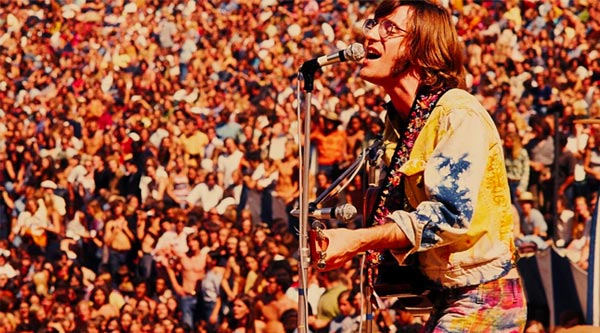
Over masks, social distancing, and a cold beer in his yard recently, I told John I was doing a blog for MWS on tie-dye because it was seeing a real resurgence. It is a great activity for the whole family and I asked John if he’d do an interview about his very cool tie-dye period. He graciously agreed. So on a recent morning, we sat outside surrounded by dogs and cats and talked about those tie-dye days.
John Sebastian The Tie-Dye Master: How it began
When did you start Tie-Dyeing?
“In 1969. I went to LA after an east coast divorce. I took up lodging on a little hill off a back road Burbank behind a friend’s rented complex. There were about 5 buildings, two were for living, the others were garages and back houses that you could do in LA in those days. My pal Cyrus Faryar, of The Modern Folk Quartet, said on top of the hill we have a Volkswagon bus tent. He added you could probably throw a hundred bucks a month toward this thing. It was a perfectly adequate place to start for me, This was a loosely allied group of people. It was referred to as The Farm like a hundred other locations in that period. It was nothing fancy. It had been Lady Barham’s hunting lodge in the 1920s. That’s how much LA has changed.”

“One of the many residents was a woman named Ann Thomas, a great gal from Brooklyn who had a hundred talents, tremendously artistic. At that time she was primarily doing batiking and Indian nail dyeing. Out of that, I don’t know if she saw tie-dyeing in some historical context or some friend of hers showed her the technique, but she immediately became interested. She claimed it had to be Pisces stuff and it’s perfect I said hey I qualify (John’s birthday is March 17th which makes him a Pisces). So I began to tie-dye in a funny little basement porch. It was bad, that was lye and stuff and at the end of the day, we would just toss it down the hill. “
Were you working as a musician at the time?
“Yes, at that time I was beginning my first solo album, I already had all these friends who’d moved to LA including my producer. It’s basically The Echo in the Canyon story. (Echo in the Canyon is a 2018 documentary that celebrates the explosion of popular music that came out of LA’s Laurel Canyon in the mid-’60s.)”
John Sebastian The Tie-Dye Master: The Process
Do you remember the first thing you tie-dyed?
“I probably started with something like a T-shirt. The dyes and everything in many cases were already made because Ann Thomas would have a project and there would be large jars and pans of hot dye. The temperature was only semi-important, it’s how long its been in the dye. So I would take advantage of these end moments. I’d think oh gee there is more of that screaming turquoise color that I like, so I’d tie up my shirt and throw it in. It did begin to become a thing I was doing and I began to have a sort of a style of doing it.”
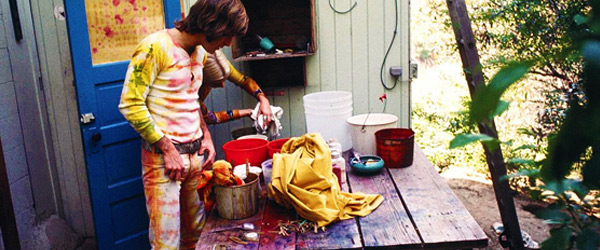
What was the draw of tie-dyeing?
“It was a fascinating process because not only were you kind of composing some channels for this dye to get in but you were also going to see it flip on the color wheel because that’s what aniline dye does. It is a photographic process. So you have stirred up the thing that says yellow on the jar and you put the stuff in. It’s the darkest purple you’ve ever seen, you don’t believe it. You go Nah this isn’t going to work. So it usually has about 40 minutes in the dye, it would come out and we would hose it off and set it in the California sun and you’d start to see this process of the thing flipping from one side of the color wheel to another.”
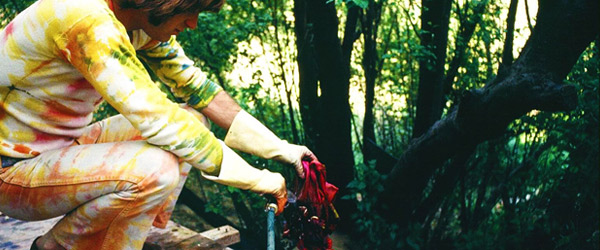
So you loved it and continued?
“It was exciting and contagious in the sense that lots of people would come to the farm. Remember there were six different creative types actors, musicians, artists, all sorts of people that attracted other people to them to do what they do. So, of course, all the corollary people would say I want to get in on this and start taking clothes off. And so now when there were four or five different people making the colors you might have 12 different pots. You finished doing what you intended to do and literally that’s when socks and underwear got tie-dyed. By the time Catherine (John’s wife of 50 years and also my very dear friend) and I were in the 2nd year of our relationship everything was tie-dyed, sheets, blankets, clothes, shoes, underwear.”
 How much of your day was spent tie-dyeing?
How much of your day was spent tie-dyeing?
“Some times I had a session or concert and I’d go off, but during that time it was sort of the afternoon recreation. “
How long did your tie-dyeing adventure last?
“I’d say it started in the Spring of 1969 and it was just something we were doing but at some point or another in the summer was when I actually went and bought a white Levi jacket. (This jacket became the iconic symbol of Woodstock and John Sebastian) I decided I was really going to have fun with this, I wasn’t going to rush it or just toss it in the dye, I’m going to tie little teeny parts and let it just take forever and that’s what I did with the Woodstock jacket, just one part at a time. So there are a lot of colors on that jacket and they sort of represent The Farm because I would dip into other people’s pots whenever possible.”

Did you actually start the tie-dye trend?
“No it was all Annie. People didn’t know her last name. They called her Tie-Dye Annie for years and years. She didn’t like it after a while. She had other artistic endeavors. She was a colorful person who’d had an unusual life and hard to get to know. We got along, but if you struck her wrong it would not go well.”
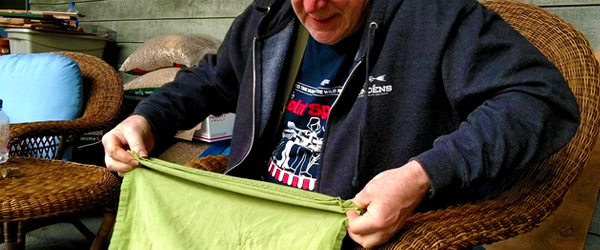
John Sebastian The Tie-Dye Master: Tricks and Techniques
Did you develop a special technique?
“It started with the real simple stuff, like a mandala. so you start grabbing as much fabric as you can but you don’t just twist it because you want to get the dye to do stuff. Now according to how much pressure you put on the twist will determine how much dye gets in there. If you tie a lot of rubber bands you are just going to get veins of color. But if you make it a little floppy and toss it in it will be more cloudy. Annie used to talk about guitar fingers. I’d do folds which I could constrict. she attributed it to having strong fingers “guitar fingers.”
So is guitar fingers your signature trick or style?
“It’s all style, there is no good or bad there is only dull and faded. That’s the failure. I remember being at Woodstock and teasing the shit out of Joe Cocker because he had gotten a Procion dyed T-shirt from San Francisco and had worn it a couple of times and I said “man you got to do it right, that doesn’t look good. That just looks dirty.”
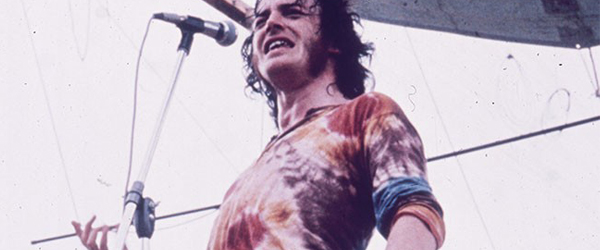
Joe Cocker, Woodstock
“So different people had different styles. Women with little fingers could do one thing. We had a pal Jake who was 7’8” he was gigantic and he would do stuff that we’d say wow, it’s the same idea but the pattern is bigger.
All this tieing and dyeing can be augmented by tie bleaching. It’s tie and fire up the bleach. It’s bleach and water. You put on industrial gloves and you put it in quick and out quick. You are trying to keep it from burning holes. It was magic sort of medieval and dangerous. That was the year I had interestingly dyed hair. It wasn’t intentional. We had leftover bleach, I was working with and I’d run my fingers through my hair without thinking. After about a month of doing that I realized I had a Detroit boxcar type thing going on.”
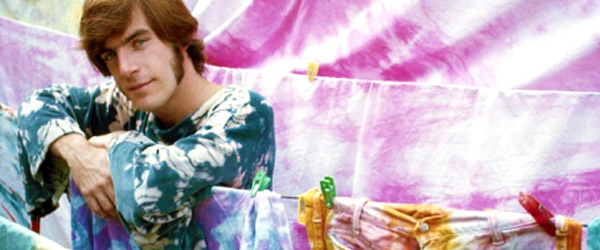
What was the best part of tie-dyeing?
“It’s two questions in one the best part and the worst part. It’s the waiting and you go oh no I can tell already that the yellow is going to make a puke color instead of what I was hoping for.”
Why did you stop tie-dyeing?
“There were several factors. Time: music is a relentless mistress. Catherine and I carried dyes for a long time. We dyed in England and San Francisco. We’d go down to Coconut Grove and tie the crap out of Freddy Neil until he and his wife didn’t have any clothes that weren’t tie-dyed. I still have people who say you tie-dyed me a shirt and I think, shit I don’t remember that. It was flying by, it was going fast.”
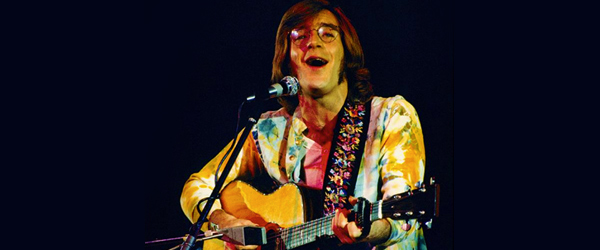
Did you ever tie-dye with your kids?/ Would you show your grandkids how?
“My son Ben was impersonating me in a third-grade event and we tie-dyed a shirt. Sure I’d show grandkids the Procion version of it. tie-dyeing is a happy memory. “
You know Tie-Dye is coming back?
“I know, before the quarantine, I went To Kohls and there was row after row of women’s summer dresses and shirts all tie-dyed.”
Would you pull out your old stuff?
“I haven’t thrown anything away. I’ve had some interest from people who want to buy the collection. I would sell it. I still have it all.
You know, the moment I thought this is probably over. I was watching a late-night talk show and Cheech and Chong were on. And they sit down and Cheech is wearing a tie-dyed shirt with lots of colors. The host complimented the shirt and said so you tie-dye your own shirts, right? And Cheech said no I threw up.”

I am very grateful to John for being so generous with his time and stories. I loved every minute of this interview and I adore John and his beautiful wife Catherine who is a talented artist and photographer. There are still countless stories from his truly remarkable life to be told and an extraordinary legacy of music.
